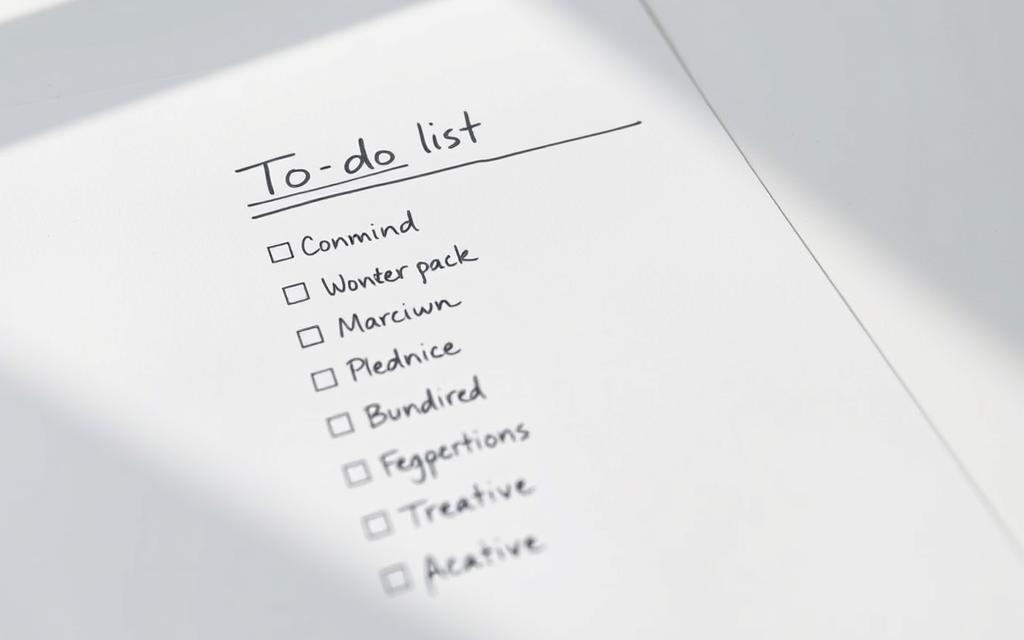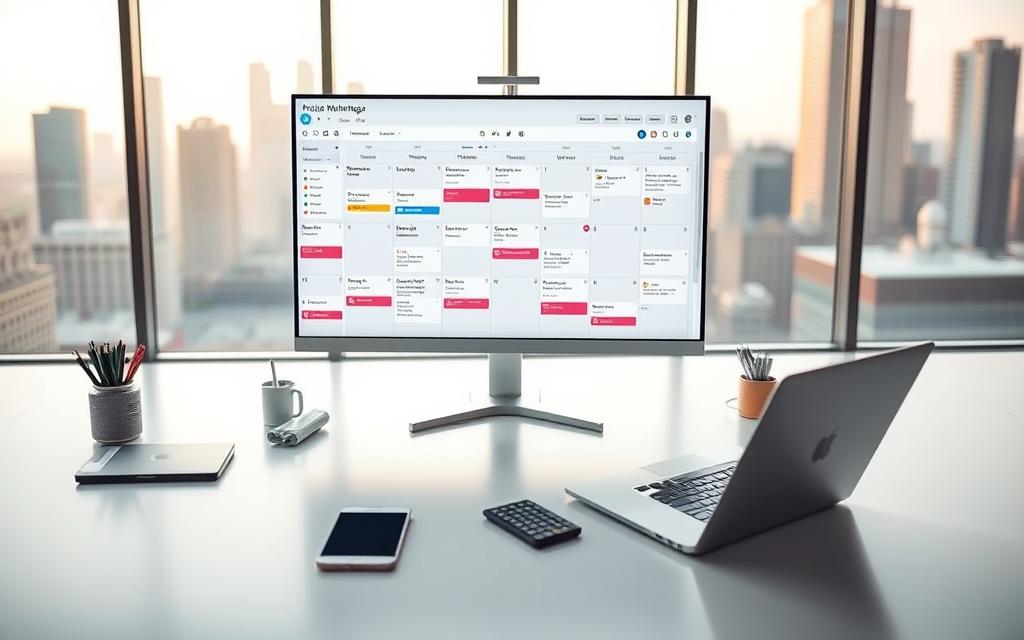Ever feel like there’s never enough hours in the day? You’re not alone. The truth is, how you organize your daily tasks directly impacts your ability to achieve goals and reduce stress. As research from the University of Georgia explains, it’s less about “managing minutes” and more about aligning priorities with the 1,440 minutes we all get daily.
Think of your schedule as a puzzle. When pieces fit smoothly, you gain energy, focus, and even free moments for hobbies or relaxation. Simple tools like digital calendars or task lists can transform chaos into clarity—helping you accomplish more without burnout.
This guide will walk you through practical methods to streamline routines, prioritize what matters, and ditch habits that drain productivity. Whether you’re balancing work, family, or personal projects, these strategies are designed to help you take control—not just check boxes.
Ready to stop chasing the clock? Let’s explore how small adjustments create big results.
Grasping the Fundamentals of Time Management
Mastering daily tasks starts with recognizing each moment’s potential. At its core, effective organization involves aligning actions with priorities—whether you’re preparing for a presentation or helping kids with homework. Tools like Covey’s Matrix highlight this by sorting tasks into four categories: urgent, important, and everything else. This approach helps people focus on what truly moves them toward their goals.
Understanding the Value of Every Second
Small moments add up. A five-minute distraction during work might seem harmless, but over weeks, it could cost hours of progress. For students, wasted minutes between classes can turn into missed study opportunities. Research shows consistent routines reduce stress and improve focus, creating a ripple effect in both professional and personal life.

How Priorities Shape Productivity and Well-Being
Covey’s framework emphasizes that planning isn’t about filling every slot in a calendar. It’s about choosing activities that matter. For example, dedicating mornings to high-focus tasks often leads to better outcomes than scattering energy across trivial items. A teacher grading papers first thing or a developer tackling complex code early both benefit from this intentional structure.
Clear objectives act as guideposts. When goals are specific—like finishing a report by noon or exercising three times weekly—they transform vague intentions into actionable steps. This clarity not only boosts output but also creates space for relaxation, proving that smart organization enhances life quality.
Analyzing Your Daily Time Usage
Ever catch yourself scrolling through your phone when you should be working? Understanding exactly where your hours go is the first step to reclaiming your day. Research from the University of Georgia recommends tracking activities in 15-minute blocks for three days—you’ll spot patterns you never noticed.
Utilizing Time Logs for Self-Assessment
Start by jotting down every task, from coffee breaks to meetings. Apps like Toggl or a simple spreadsheet work wonders. Studies show people often underestimate how long routine activities take—like answering emails or commuting. Comparing planned hours versus actual hours spent reveals gaps in your schedule.
Identifying Key Time Drains and Distractions
Look for clusters of low productivity. Maybe mid-afternoon social media binges or multitasking during creative work. A teacher might lose 20 minutes daily searching for materials; a freelancer could waste hours on unclear client requests. Once you name these thieves, you can redesign your day around meaningful tasks.
Pro tip: Review logs weekly. Notice recurring interruptions? Block specific hours for deep focus. Small tweaks—like silencing notifications—add up to big gains. Remember, awareness fuels better choices.
Prioritizing Tasks with Proven Methods
What separates high achievers from the overwhelmed? The answer lies in strategic task prioritization. By focusing on what truly drives results, you can cut through clutter and reclaim hours. Let’s explore two battle-tested approaches to organize your workload.

Applying the Eisenhower Matrix Effectively
This method sorts activities into four categories: urgent/important, important/not urgent, urgent/not important, and neither. For example:
- Urgent & important: Client deadlines
- Important & not urgent: Skill development
- Urgent & not important: Most emails
- Neither: Social media scrolling
A marketing manager might use this to delay non-critical meetings (quadrant 3) while scheduling campaign strategy sessions (quadrant 2). Studies show this framework reduces decision fatigue by 40%.
Building Manageable and Prioritized To-Do Lists
Start with these steps:
- List every task—no filtering
- Assign ABC labels (A=critical, B=helpful, C=optional)
- Break A-tasks into 30-minute chunks
Teachers often group grading (A), lesson planning (B), and classroom decorating (C). Apps like Todoist let you drag-and-drop items as priorities shift. As highlighted in this productivity guide, saying “no” becomes easier when your list reflects true goals.
Remember: A shorter, focused list beats a long one collecting dust. Try these tips today—your future self will thank you.
Leveraging Planning Tools and Scheduling Techniques
Imagine having a personal assistant who organizes your day—except it’s free and fits in your pocket. Modern planning tools act like GPS for your week, guiding you through tasks while adapting to sudden detours. Let’s explore how to sync these resources with your goals for smoother days.

Integrating Digital Calendars and Apps
Apps like Google Calendar or Todoist turn chaotic to-do lists into structured action plans. Color-coding work projects blue and family events green creates visual clarity. Studies show people who sync calendars across devices complete 23% more tasks weekly.
Try these steps:
- Block fixed commitments first (meetings, classes)
- Assign priority tags to flexible tasks
- Set reminders 15 minutes before transitions
Freelancers using Asana report finishing client work faster by automating deadline alerts. Pair tools with tutorials—like Coursera’s productivity courses—to master advanced features.
Creating a Consistent Daily Schedule
Consistency turns plans into habits. Start mornings with high-energy tasks, reserve afternoons for collaborative work, and wind down with creative projects. A teacher might structure their day like this:
- 7–8 AM: Lesson preparation
- 10–11:30 AM: Student sessions
- 3 PM: Administrative tasks
Build in buffer zones between appointments. A 10-minute walk after 90 minutes of focused work boosts mental freshness. Tools like Trello help adjust schedules when surprises arise—without derailing entire days.
Remember: The best schedule bends but doesn’t break. Test different templates until you find one that fuels progress and peace of mind.
Delegating Tasks and Minimizing Interruptions
True productivity thrives when collaboration meets focused effort. Sharing responsibilities and creating distraction-free zones lets you channel energy into high-impact activities. Let’s explore how to delegate smarter and silence digital noise.

Strategies for Sharing Workloads
Delegation isn’t about dumping work—it’s strategic trust-building. Start by identifying tasks others can handle:
- Administrative duties like scheduling or data entry
- Household chores through shared family calendars
- Repeatable processes that need consistency, not expertise
As highlighted in this guide on effective delegation, clear communication prevents misunderstandings. Specify deadlines, preferred methods, and check-in points. A project manager might assign research to interns while focusing on client presentations.
Managing Social Media and Digital Distractions
Smartphones and apps compete for attention daily. Try these steps:
- Turn off non-essential notifications after work hours
- Schedule 10-minute “media breaks” three times daily
- Use apps like Freedom to block distracting sites during focus sessions
Studies show people regain 2.3 hours weekly by limiting aimless scrolling. Teachers using “do not disturb” modes report finishing grading 35% faster. Your inbox can wait—protect your creative flow first.
By combining smart task-sharing with digital boundaries, you’ll reclaim mental space for what truly matters. Less clutter means more control over your priorities and reduced stress. Start small: delegate one task today and silence one app. Progress builds momentum.
Essential Time Management Strategies
Struggling to maintain focus during busy days? The right approach turns chaotic workloads into achievable wins. Two standout techniques—Pomodoro and Kanban—help structure tasks while keeping motivation high.

Harnessing Focused Work Intervals
The Pomodoro Technique uses 25-minute work blocks followed by 5-minute breaks. After four cycles, take a longer pause. This method combats burnout by:
- Preventing mental fatigue through regular rest
- Creating urgency to complete tasks within time limits
- Making large projects feel less overwhelming
Students often use this strategy to study for exams without zoning out. A 2021 study in the Journal of Applied Psychology found workers using timed intervals completed 28% more tasks daily.
Visualizing Progress with Kanban
Kanban boards organize workflows into columns like “To Do,” “In Progress,” and “Done.” Teams at companies like Spotify use this method to:
- Break complex projects into clear steps
- Identify bottlenecks quickly
- Celebrate completed items visually
Freelancers managing multiple clients often customize digital boards using Trello. Moving tasks between columns provides momentum—a physical reminder of progress that cuts procrastination.
Try both strategies for a week. Track which one helps you finish reports faster or tackle household chores more efficiently. As productivity expert James Clear notes: “Systems beat willpower every time.” Your ideal technique awaits discovery.
Balancing Work, Life, and Digital Well-Being
Juggling career demands and personal passions often feels like walking a tightrope. The constant ping of notifications and blurred lines between professional and private hours can leave anyone drained. Studies reveal that 67% of professionals struggle to disconnect from digital devices, leading to burnout and strained relationships.

Creating Boundaries for a Healthier Routine
Start by defining clear zones for work and leisure. Designate tech-free spaces at home—like the dinner table or bedroom—to foster genuine connections. A teacher might silence work emails after 7 PM, while a freelancer could block weekends for family activities.
Morning rituals set the tone for success. Try these habits:
- Drink water before checking your phone
- Write three daily priorities in a journal
- Exercise for 15 minutes to boost energy
Develop skills that protect your mental space. Use app timers to limit social media scrolling, or batch-check emails twice daily. Research shows people who build self-confidence through boundary-setting report 40% lower stress levels.
Remember: Balance isn’t about perfection. It’s creating systems that let you thrive in both career and personal life. Small changes—like a “no screens” breakfast—build resilience against digital overload. Your well-being deserves this intentional care.
Conclusion
Transforming your daily routine starts with actionable steps, not grand overhauls. By aligning priorities, leveraging tools like the Eisenhower Matrix, and setting clear goals, you create a roadmap for sustainable progress. Whether tackling work projects or school assignments, structured methods help you focus energy where it matters most.
Consistent planning remains key. Build schedules that adapt to surprises while protecting blocks for high-impact tasks. Tools like Kanban boards or digital calendars turn chaotic days into organized workflows. Remember to review and adjust your strategies for weekly—flexibility ensures long-term growth.
Delegation and boundary-setting amplify results. Share tasks that others can handle, freeing time for creative problem-solving. Pair this with focused intervals (like Pomodoro sessions) to maintain momentum without burnout. Students and professionals alike benefit from these approaches, proving that smart organization transcends environments.
Start small: pick one tip today—maybe time-blocking mornings or silencing notifications—and track its impact. Progress builds over weeks, not days. As you refine your system, celebrate milestones and learn from setbacks. Ready to take charge? Your most productive self awaits.
